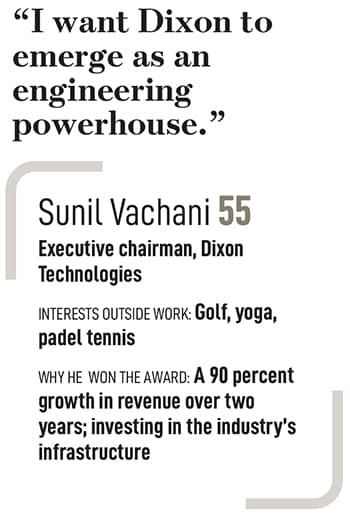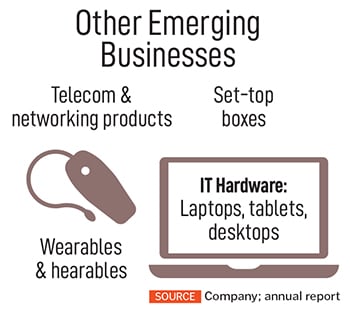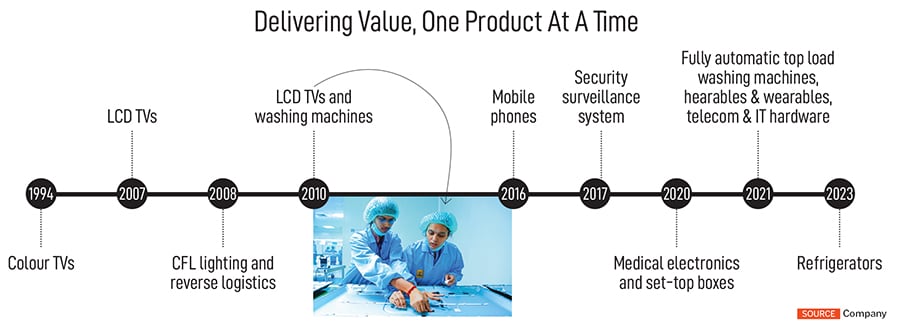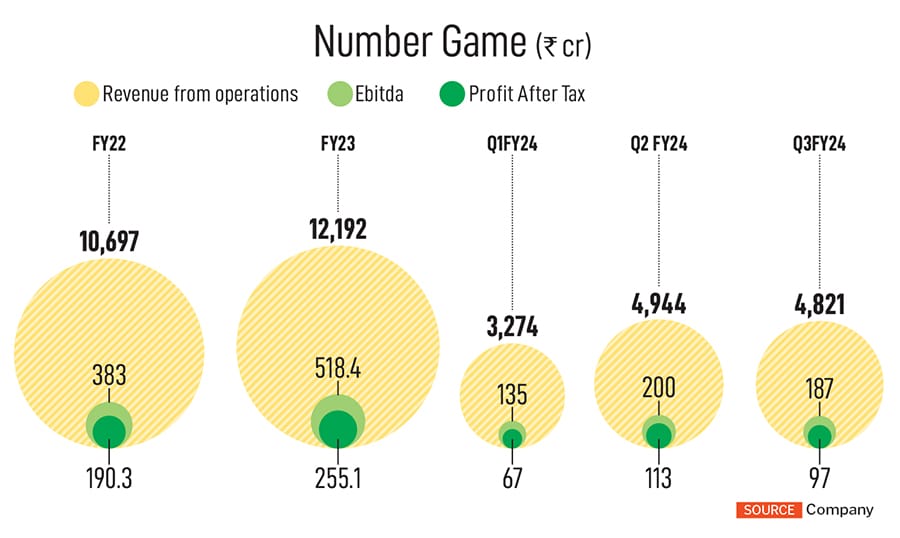Sunil Vachani: In a relentless pursuit of excellence for global domination
After becoming the largest electronics manufacturing services company in India, Sunil Vachani now wants Dixon Technologies to transform into a global powerhouse


In 2022, Sunil Vachani’s vision for Dixon Technologies was for it to become the largest electronics manufacturing services (EMS) company in India. Two years later, Vachani is beaming with pride as this milestone has been achieved. “My vision has expanded. Now, I want Dixon to emerge as an engineering powerhouse," he says, as we sit at Dixon’s wholly owned subsidiary Padget Electronics’ new 1.3 lakh sq ft smartphone manufacturing facility in Noida. He wants the company to be one of the top 10 global EMS companies in the next five years, and top five in the next 10 years.
“But for this to happen, a lot will have to change," reckons the co-founder and executive chairman. There are plans for heavy investments in infrastructure capabilities, backward integration and skill development of the workforce. Over the last two years, close to five new manufacturing units have been added and a mega campus of close to 1 million sq ft is in the works. “To become globally competitive, you need scale. This will help us achieve that," he says.
The company has clocked a turnover of ₹12,192 crore in FY23, approximately a 90 percent growth compared to its revenue of ₹6,448.2 crore in FY21. Its market capitalisation stands at ₹37,921 crore and, over the last one year, its share price has increased by over 135 percent (as on February 14).
Given its strong financial performance and strategic decisions that have helped the company and industry grow, 55-year-old Vachani is the Entrepreneur of the Year at the Forbes India Leadership Awards 2024.
“Vachani is a forward-looking leader with a strategic vision and a relentless pursuit of excellence. His adeptness in navigating dynamic markets, adopting new manufacturing practices, and cultivating robust partnerships has been instrumental in Dixon’s successes," says Muralikrishnan B, president, Xiaomi India.
Dixon’s beginnings trace back to 1993, when Vachani first set up a CRT TV (television) manufacturing factory on a 10,000 sq ft rented plot in Noida with a few machines, 15 employees and ₹15 lakh that he borrowed from his father, Sundar Vachani.
 In the early 1990s, after completing his Associates in Business Administration from American College, London, Vachani returned to India. He could have joined the family business, but he wanted to do something on his own. Thus, began his tryst with entrepreneurship. And through all these years, a piece of his father’s advice stayed with him: “Always have a microscopic and telescopic vision at the same time. You need to keep an eye on the big picture, but at the same time, not miss out on the small details."
In the early 1990s, after completing his Associates in Business Administration from American College, London, Vachani returned to India. He could have joined the family business, but he wanted to do something on his own. Thus, began his tryst with entrepreneurship. And through all these years, a piece of his father’s advice stayed with him: “Always have a microscopic and telescopic vision at the same time. You need to keep an eye on the big picture, but at the same time, not miss out on the small details."
In 1989-90, he set up a factory to make cordless telephones, but it didn’t take off because of some missteps. Thereafter, he started training at his father’s TV manufacturing company, Weston, in the components department. After a year-and-a-half, he told his father that he wanted to set up his own venture—manufacturing electronics. “At that time, the concept of manufacturing for other people was alien everybody believed that manufacturing is sacred, it has to be in-house and not outsourced. So, rightly, my father was a little apprehensive," recounts Vachani. The then-23-year-old had noticed a similar trend in a few global markets, and was certain it would come to India, soon enough. Eventually, his father agreed. But he asked “his blue-eyed boy" Atul Lall—who had worked at Weston for many years—to mentor Vachani.
Almost a year into setting up Dixon, they bagged their first order from Lucky-Goldstar—now LG Electronics—which, in those days, only had a representative office in India. It was looking for a subcontractor to manufacture a few thousand TVs for exports. Vachani and Lall quoted a fee of only $1.5 per TV, because “we were so desperate for business".
Later, when Lucky-Goldstar moved to India, Dixon was on-boarded to manufacture TVs for the domestic market. Post that, the company bagged clients like Phillips for consumer durables, DVDs, audio and VCRs, and SEGA for video games consoles. Today, it is the largest EMS manufacturer in India, with over 110 customers, including the likes of Xiaomi, Samsung and Nokia, among others.

When Xiaomi was entering the smart TV market in India, the company was looking to collaborate with a partner that would match their global standards and demonstrate the technical expertise to manufacture their top-tier products. “After carefully considering these factors, Dixon qualified all the parameters, resulting in our partnership for smart TV manufacturing in 2018, extending to smartphone manufacturing last year," says Muralikrishnan. Over time, Dixon has evolved to meet international benchmarks and ensure our products consistently meet the highest standards."
For the first eight or nine years, the company was focussed on one product—CRT televisions. “We were quite naive, practically running operations ourselves and didn’t think too much about the bigger picture. Then certain shocks came around 1997, when the export business closed. We realised this was a risky strategy, and tough to scale," recalls Lall. Soon, Lall and Vachani realised they needed to expand their core, which wasn’t TV—it was electronics manufacturing.
Yet another key learning for Dixon was when it launched its own brand in early 2000s. “Sometimes the decisions of what not to do are far more important than what to do," says Vachani. After two-and-a-half-years, they realised Dixon’s core offering had to be electronics manufacturing as a service, and not a brand. “This was a turning point for us… things started falling into place," says Vachani. That’s when Dixon got its tagline: The brand behind brands.

It was this philosophy, recalls Ravi Kunwar, VP, India & APAC, HMD Global (Nokia), that resonated well with HMD’s team. In 2021, Dixon entered into an agreement with HMD India for manufacturing Nokia smartphones. “Dixon is India’s top EMS player for multiple reasons—understanding government and localisation requirements production linked incentives shared with partner scale, technology and competitive for exports as well as local consumption backward and forward integration and being quality obsessed," says Kunwar.
One of the biggest reasons for the company’s exponential growth over the last two years: Expanding its mobile phone category—which includes both smartphones and feature phones.
Overall, the domestic mobile phone market is likely to grow at a CAGR of 9.7 percent, expected to reach 370 million units by FY26. About five to seven years ago, Dixon had a capacity to manufacture close to 100,000 phones per month. Today, its total capacity across four plants is almost 70 million phones per year. “India’s total market is about 220-250 million phones, this means Dixon has covered almost 30 percent of its total market requirement," reckons Vachani. Soon, the EMS powerhouse hopes to touch 100 million phones a year.

Outside of its existing product portfolio, some of the emerging categories for the company include wearables and hearables, where they have a joint venture with boAt, and telecom, where they have a joint venture with the Bharti Group and also cater to Jio. The latest addition to its consumer durables portfolio—refrigerators—is already seeing a healthy order book.
Vachani is bullish about the IT hardware segment as well. The company’s subsidiary Padget Electronics has won a contract from Lenovo to manufacture its laptops and notebooks, under the IT hardware production-linked incentive 2.0 scheme. This is in addition to its already existing contract with fellow industry leader, Acer.
The overall market for this segment is close to ₹120,000 crore—which means there is scope for expansion. Of Dixon’s total revenue, this segment accounts for only a minuscule percentage—about ₹86 crore. About 95 percent of the products in the segment are imported.
“So, there is a huge scope for import substitution and backward integration. Over time, we feel India could be a great market for exports of these products and we see a very large play for us," he says. Vachani feels that even if Dixon caters to 10 percent of this huge market, “you are talking about an incremental turnover of almost ₹10,000 crore". Given how different the complexity of the product is, the rollout in this segment is taking some time for Dixon, but Vachani is confident that by August or September, manufacturing will begin.

Lighting is one area where the company has been struggling and doesn’t have a healthy order book. Dixon’s focus was purely on the bulbs segment, whereas over 50 percent of the market includes large-scale professional and commercial lighting. Vachani explains, “When the government launched the Ujjwala scheme, there was a massive distribution of LED bulbs at subsidised rates. Penetration levels are very high, and LED bulbs last a lot longer than CFL. Hence, that market is under huge pressure." He admits there is a need for course correction, and research and development is underway for professional and commercial lighting solutions.
As digitisation has started touching all segments—from automotive and medical devices to drones and defence—there is potential for electronics manufacturing in each of these areas. While Dixon is working mostly on the consumer-facing electronics, it is also hoping to cater to these segments. “In these sectors, you work on lower quantities, but higher margins—high value EMS activity," explains Vachani, who believes that this division will contribute significantly to revenues. Similarly, the Original Design Manufacturer (ODM) segment has higher margins compared to EMS. Hence, Vachani and his team are also investing big time in designing solutions—which will allow Dixon to truly become an engineering powerhouse.
According to the ICEA, mobile phones account for 46 percent of electronics goods exports and are predicted to reach $50 billion by FY26. Three years ago, Dixon had almost negligible exports. “In FYF23, our exports were almost ₹1,200 crore, and this year they are expected to be close to ₹2,000 crore," says Vachani. Clearly, there is a lot of potential to export.
India is now exporting smartphones to developed markets, including the UK, Italy, France, Middle East, Japan, Germany, and Russia. “This can only be sustainable if we have a components ecosystem, and in that Dixon will have to take the lead with some investments," he adds. The company plans to make substantial investments into the components ecosystem—particularly mobile components—since there is still high reliance on imports for the same.

Even with job creation, the production linked incentive scheme has incrementally boosted 5 lakh jobs creation in the mobile manufacturing industry alone, according to Union Minister of Electronics & Information Technology Ashwini Vaishnaw. “Manufacturing brings about social change by creating a huge number of jobs, even for women. Currently, less than 10 percent of women are employed in the sector. But with more focus on the sector, this is likely to change soon," he says. Dixon’s Tirupati factory has a 65 percent women workforce.
In scaling up the industry, skill development is another key factor. Dixon’s team has been working with ITIs to see how the curriculum can evolve to make it more industry ready. “The workforce needs to be trained on quality system processes, industry 4.0, dashboard management, among many others," explains Vachani. Dixon’s team is also setting up centres of excellences to provide in-house training.
In January, Vachani took up the role as president of Consumer Electronics and Appliances Manufacturers Association. The ‘paranoid entrepreneur’, as he calls himself, wants to start taking a backseat from Dixon’s daily operations. “The toughest thing for an entrepreneur to do is let go. Atul [Lall] often tells me I dive into issues too deep… you know, old habits die hard," he laughs.
First Published: Mar 11, 2024, 16:55
Subscribe Now